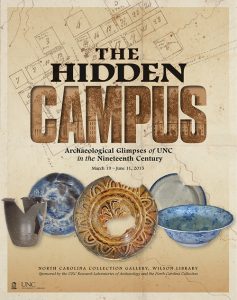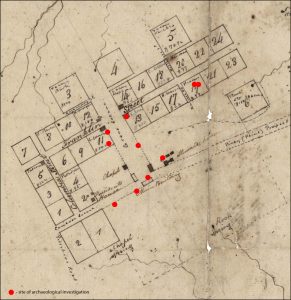UNC’s Hidden Campus
 This exhibit presents the results of archaeological investigations that have been undertaken on the University of North Carolina campus since 1991. These projects were undertaken by archaeologists and students from UNC’s Research Laboratories of Archaeology, and most yielded important new information about the campus prior to 1900. In 2015, an exhibit about campus archaeology titled “The Hidden Campus: Archaeological Glimpses of UNC in the Nineteenth Century” was featured in Wilson Library’s North Carolina Collection Gallery. This is a web version of that exhibit.
This exhibit presents the results of archaeological investigations that have been undertaken on the University of North Carolina campus since 1991. These projects were undertaken by archaeologists and students from UNC’s Research Laboratories of Archaeology, and most yielded important new information about the campus prior to 1900. In 2015, an exhibit about campus archaeology titled “The Hidden Campus: Archaeological Glimpses of UNC in the Nineteenth Century” was featured in Wilson Library’s North Carolina Collection Gallery. This is a web version of that exhibit.
For more than a century after opening its doors to students in 1795, the University of North Carolina grew slowly and by 1900 its campus was comprised of less than a dozen buildings situated along Cameron Avenue and McCorkle Place. Chapel Hill during this period was a small town whose residents and businesses were, almost without exception, directly connected to the support of the University. While a majority of those early campus buildings and many historic houses have survived into the twenty-first century, most commercial and other structures at the town’s center are now gone, and significant portions of the early commercial district have been incorporated into the modern campus. Because of this transformative growth in the twentieth century, the overall character of the early campus and adjacent town is now largely hidden from view, known primarily through early written descriptions, stylized engravings, historical photographs, and, of course, UNC’s surviving nineteenth-century buildings—Old East, Old West, South Building, Person Hall, Gerrard Hall, Smith (Playmakers) Hall, New East, and New West.

Over the past three decades, another source of information has been used to reveal glimpses of the early campus. Since 1991, archaeologists at UNC’s Research Laboratories of Archaeology have conducted numerous archaeological investigations on campus, ranging from limited site investigations and monitoring of ongoing construction projects to full-scale excavations. Most, but not all, of these studies were undertaken to fulfill the University’s statutory obligations under North Carolina’s Archaeological Resources Protection Act, and collectively they provide a unique resource for viewing the university community during its first one hundred years. The buried architectural remains and associated artifact assemblages found at several of these sites, particularly those located adjacent to downtown Chapel Hill and within the core area of the original campus, recall a quaint era of college and town life that now lies beyond personal memory. In short, they reveal glimpses of the now-hidden campus.
The map at right shows a plan of the university village of Chapel Hill and the few buildings that comprised the University of North Carolina campus at the beginning of the nineteenth century. The red dots identify sites containing late eighteenth-century and nineteenth-century archaeological resources that have been investigated by UNC’s Research Laboratories of Archaeology.
Contributor
R. P. Stephen Davis, Jr. (Research Laboratories of Archaeology, University of North Carolina, Chapel Hill)
*Image courtesy of the North Carolina Collection, University of North Carolina, Chapel Hill.
Source
Davis, R. P. Stephen, Jr.
2015 • The Hidden Campus: Archaeological Glimpses of UNC in the Nineteenth Century. Gladys Hall Coates University History Lecture, Wilson Library, University of North Carolina, Chapel Hill, April 14, 2015.
